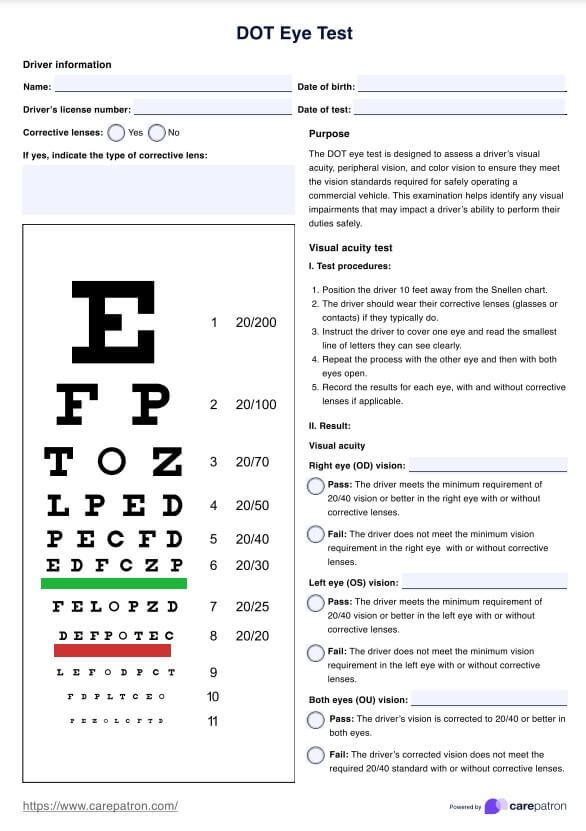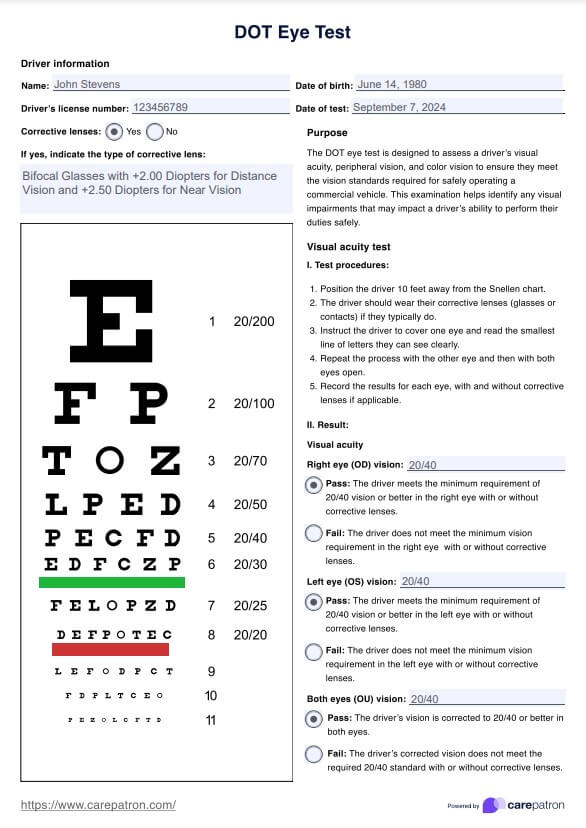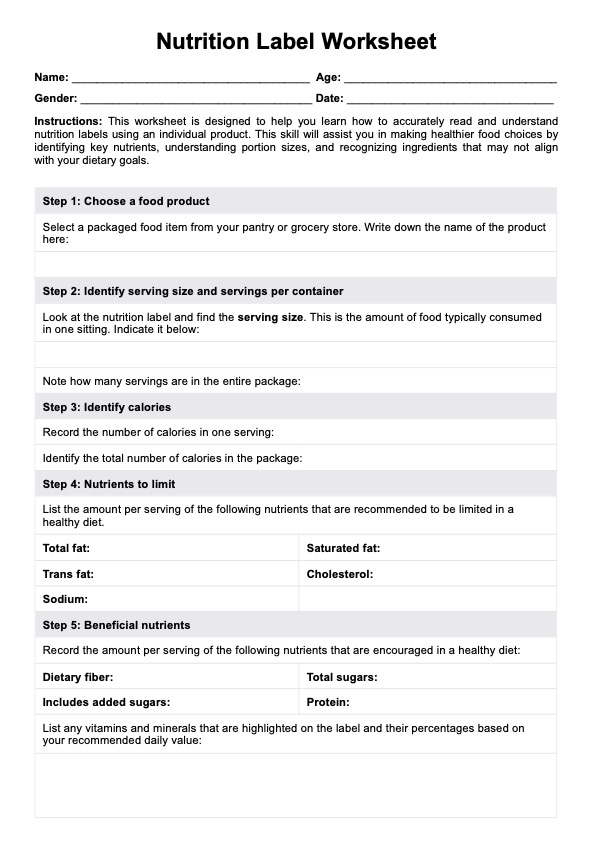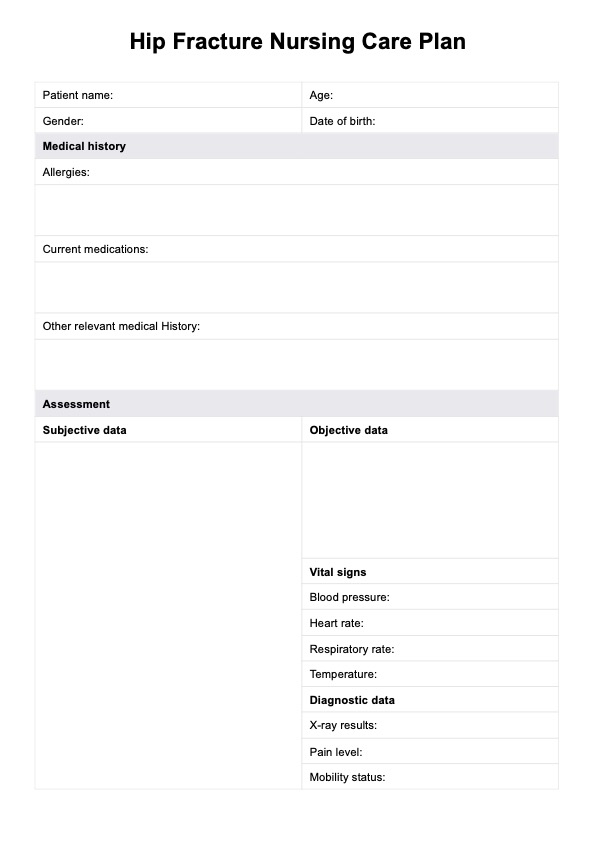Dot Eye Test
Ensure your drivers meet DOT vision standards with our comprehensive DOT Eye Test template. Use it to streamline assessments and improve safety.


What is a DOT Eye Test?
A DOT Eye Test, also known as a DOT eye exam, is a vision assessment required by the Department of Transportation (DOT) for individuals seeking to obtain or renew a commercial driver’s license (CDL). This test ensures drivers meet specific vision standards for safely operating commercial vehicles on public roads. The DOT Eye Test evaluates four key aspects of vision: visual acuity, binocular acuity, peripheral vision, and the driver's ability to recognize the colors or color vision (Ball et al., 2019).
The test is comprehensive and includes several components: a visual acuity test using a Snellen chart to measure clarity of vision, a peripheral vision test (often utilizing a confrontation test) to show blurred vision and assess the ability to see objects outside the direct line of sight, and a color vision test utilizing Ishihara plates to check for color blindness, particularly the ability to distinguish between red, green, and amber — crucial for interpreting traffic signals.
Dot Eye Test Template
Dot Eye Test Example
How to perform a Dot Eye Test
Performing a DOT Eye Test as part of the DOT physical eye exam ensures that all commercial vehicle drivers meet the necessary vision standards for safe driving. The test includes three key assessments: visual and binocular acuity, peripheral vision, and color vision. Below is a step-by-step guide for healthcare professionals on how to conduct each part of the test:
Visual acuity test
To assess distance vision and distant visual acuity and clarity, position the driver 10 feet away from the Snellen chart, ensuring the chart is at eye level and well-illuminated. Instruct the driver to cover one eye and read the smallest line of letters they can clearly see. Repeat this process with the other eye and then with both eyes open.
Record the results for each eye, noting if the driver meets the minimum requirement of 20/40 distance vision or better. The driver passes the test if their visual acuity is 20/40 or better in each eye, with or without corrective lenses.
Peripheral vision test
The confrontation test evaluates the driver’s peripheral vision. The examiner holds up a specific number of fingers in the driver's peripheral view and prompts them to identify how many fingers are being held up, which is part of the visual evaluation process.
Position yourself about 2 to 3 feet away from the driver, directly facing them in a quiet, well-lit environment. Ask the driver to cover one eye and focus on your nose or a central point directly in front of them. Extend your arms to the sides and slowly move your fingers or an object from the periphery towards the center of their visual field.
Instruct the driver to indicate when they first see the movement in their peripheral vision. Repeat this for the other eye. To pass the test, the driver must have at least 70 degrees of peripheral vision in each eye.
Color vision test
The color vision test checks for any color blindness, particularly red-green deficiencies. Use 12 Ishihara color test plates in a well-lit room. Present each plate to the driver one at a time and ask them to identify the number or pattern within each plate. Record their responses for all 12 plates.
The driver passes a physical exam if they correctly identify at least 10 of the 12 plates. If the driver incorrectly identifies 3 or more plates, it suggests a potential color vision deficiency, warranting further evaluation.
How to use our Dot Eye Test template
Our DOT Eye Test template is a convenient and structured tool designed to help healthcare professionals efficiently conduct and document each part of the DOT physical eye exam. This template ensures consistency and accuracy in assessing a driver’s vision, including using the DOT eye chart, making it an invaluable resource for your practice. Here’s how to effectively use the template:
Step 1: Download the template
Begin by downloading the DOT eye exam template from the Carepatron platform. The template is readily available through the link on this page, the Carepatron app, or our resources library. Preparing the template before the examination allows you to streamline the testing process.
Step 2: Prepare for the test
Set up your testing environment according to the instructions provided in the template. Ensure you have the necessary materials, including a Snellen chart, Ishihara color plates, and a well-lit space for conducting the peripheral vision test. In the designated fields of the template, enter the driver’s initial details, such as their name, date of birth, and driver's license number.
Step 3: Conduct the tests and record the results
Follow the step-by-step procedures outlined in the template for each part of the DOT Eye Test: visual acuity, peripheral vision, and color vision. As you conduct each test, use the template to record the driver’s responses and results accurately. The structured format guides you through the process, ensuring no details are missed, and all observations are documented thoroughly.
Step 4: Evaluate the results
After completing all the tests, review the recorded results against the various DOT vision test standards outlined in the template. The template provides clear pass/fail criteria for each test, helping you quickly determine whether the driver meets the standard vision requirements for safe commercial driving.
Step 5: Save and store the completed template
Once all template sections are filled out and the driver’s results are evaluated, save the completed template securely in the driver’selectronic health record or a physical file. This ensures the documentation is readily accessible for future reference or follow-up assessments, maintaining confidentiality and compliance with healthcare regulations.
Benefits of using our template
Utilizing our DOT Eye Test template streamlines the vision assessment process, ensuring you conduct thorough and standardized evaluations. This template offers several key advantages that enhance your practice’s efficiency and accuracy of eye exams while improving patient care.
Enhances accuracy and consistency
The DOT Eye Test template provides a streamlined format for conducting an eye exam for a vision evaluation report, typically performed by a medical examiner certified by the National Registry. It documents each test component and reduces variability in testing procedures. By following the step-by-step instructions and using predefined fields to record observations, you ensure that all necessary information is captured accurately and consistently. This reduces the risk of errors and enhances the reliability of your assessments, providing a solid foundation for determining whether a driver meets the DOT vision standards.
Saves time and improves workflow efficiency
The template is designed to be intuitive and easy to use, minimizing the time spent on preparation and documentation. With a clear structure for driver information and test instructions, you can focus more on conducting the examination rather than on administrative tasks. This efficiency is particularly beneficial in busy healthcare settings, allowing you to manage more patients effectively without compromising the quality of care.
Facilitates comprehensive patient care and follow-up
Using our DOT Eye Test template, you maintain detailed records of each driver's vision assessment, which is essential for comprehensive patient care. The template not only helps you track the results of individual tests but also provides space for additional comments and notes. This thorough documentation supports follow-up actions.
Reference
Ball, K. K., Heaton, K., McGwin, G., Owsley, C., & Stavrinos, D. (2019, November 1). Examining the FMCSA vision standard for commercial motor vehicle (CMV) drivers (University of Alabama. Birmingham, Ed.). Rosa P. https://rosap.ntl.bts.gov/view/dot/42735
Commonly asked questions
Yes, drivers can wear corrective lenses during the DOT Eye Test. If the driver relies on glasses or contact lenses to meet the vision standards, this requirement will be noted on their commercial driver’s license. It is important to test both with and without corrective lenses to document the driver’s uncorrected and corrected vision levels.
If a driver fails any part of the DOT Eye Test, they may be required to obtain corrective lenses or undergo further evaluation by an eye specialist. Failing to pass the DOT vision test could delay issuing or renewing a CDL until the driver meets the vision standards. Addressing any vision deficiencies promptly is crucial to ensuring the safety of the driver and others on the road.
Drivers with monocular vision, meaning vision in only one functional eye, must undergo specific examination procedures to assess their vision capability. They must pass the DOT physical eye exam and may qualify for exemptions. Individuals with monocular vision need official evaluations by licensed eye care professionals to determine their eligibility and ensure they meet the required vision standards.
















































































































